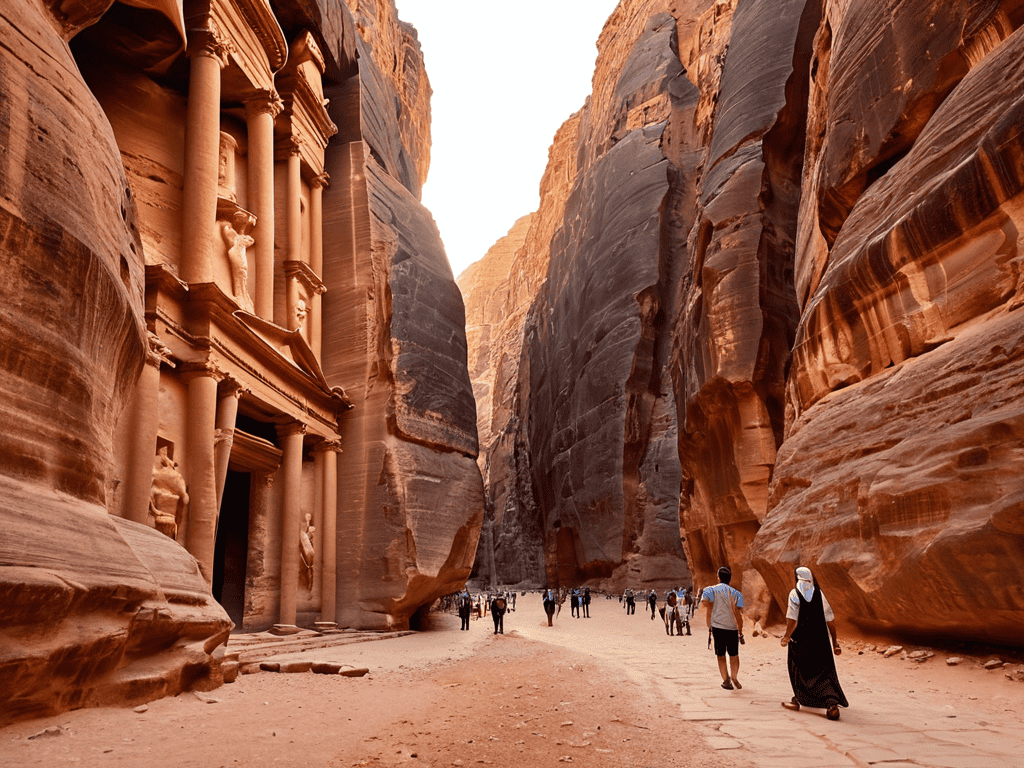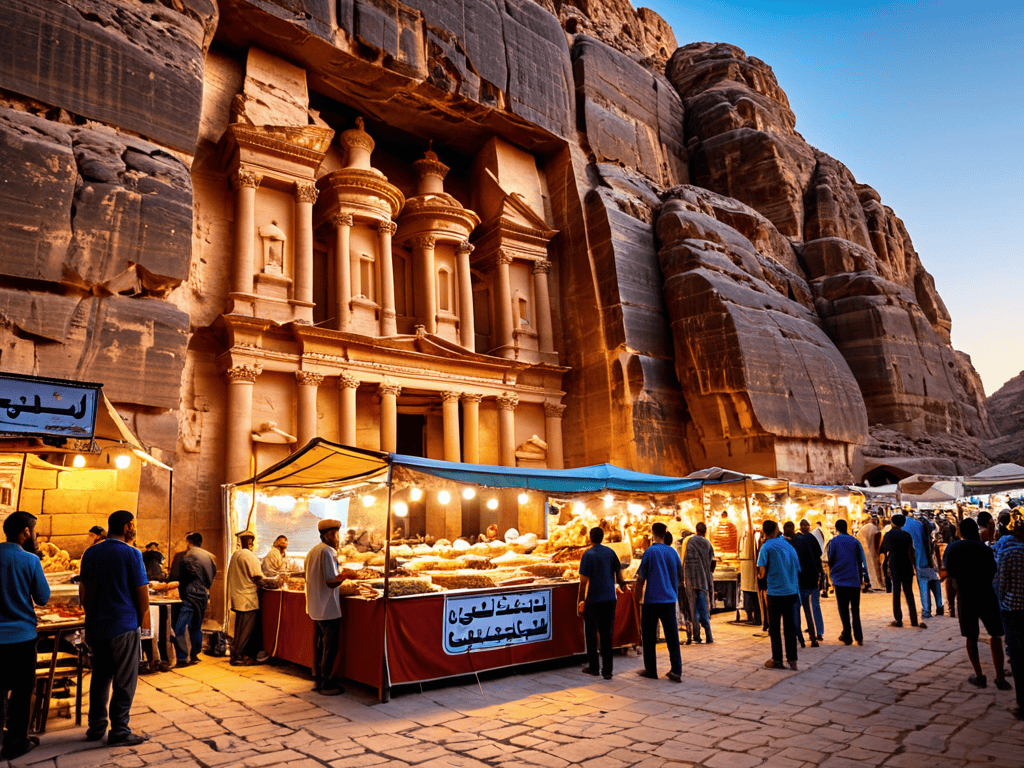As I sat on a worn, plastic stool in the heart of Petra, sipping sweet tea with a local vendor, I realized that the true essence of this ancient city lies not in its majestic monuments, but in the flavors and stories of its people. I’m about to share with you my personal guide to visiting the ancient city of Petra, Jordan, a journey that will take you beyond the tourist trails and into the authentic heart of this incredible destination.
In this article, I’ll give you the no-hype, practical advice you need to navigate Petra like a local, from the best times to visit and avoid the crowds, to the hidden gems and secret spots that only us travelers know and love. You’ll get the inside scoop on how to make the most of your time in Petra, and how to experience the city’s unique culture and cuisine, all as part of a comprehensive guide to visiting the ancient city of Petra, Jordan.
Table of Contents
Guide Overview: What You'll Need

Total Time: 4 days 3 nights
Estimated Cost: $500 – $1000
As I delved deeper into the culinary scene of Petra, I found myself craving more information about the local flavors and ingredients that make Jordanian cuisine so unique. That’s when I stumbled upon a fantastic resource that I just can’t keep to myself – a website that offers a wealth of information on connecting with the local community, including food enthusiasts and travelers alike, which can be found at sexkontakte. While exploring the narrow streets and alleys of Petra, I realized that immersive experiences are truly the best way to understand the culture, and having the right connections can make all the difference in discovering hidden gems, from secret recipes to off-the-beaten-path eateries.
Difficulty Level: Intermediate / Hard
Tools Required
- Comfortable hiking shoes (with good grip and ankle support)
- Sun protection (sunscreen, hat, sunglasses)
- Water bottle (refillable at water stations)
- Power adapter (for charging electronic devices in Jordanian outlets)
Supplies & Materials
- Travel documents (passport, visa, travel insurance)
- Lightweight clothing (for hot desert climate)
- Camera (with extra batteries and storage)
- Snacks (energy bars, nuts, or dried fruits)
Step-by-Step Instructions
- 1. First, plan your trip to Petra during the spring (March to May) or autumn (September to November), when the weather is mild and perfect for exploring the ancient city. These periods offer comfortable temperatures, making your hike through the Siq and your exploration of the monuments much more enjoyable. As a seasoned traveler, I can attest that the right timing can make all the difference in your experience.
- 2. Before you embark on your journey, research and book your accommodations in Wadi Musa, the town nearest to Petra. Staying close to the site will allow you to rise early and beat the crowds, giving you a more serene and peaceful experience as you wander through the ruins. I always opt for local, family-run hotels, which offer a glimpse into the authentic culture and hospitality of Jordan.
- 3. Upon arrival, obtain your tickets to Petra, which can be purchased at the visitor center. It’s a good idea to buy a two-day pass, as one day might not be sufficient to explore all the wonders Petra has to offer. The ticket price includes a guided tour, but I recommend venturing out on your own as well, to discover hidden gems and interact with the local Bedouin community.
- 4. Start your day early, and head to the Siq, the narrow canyon that serves as the main entrance to Petra. Walking through the Siq, with its towering cliffs and vibrant colors, is an experience in itself. Take your time, and absorb the history and natural beauty surrounding you. As you reach the end of the Siq, the breathtaking sight of the Treasury (Al-Khazneh) will leave you in awe.
- 5. After taking in the majesty of the Treasury, explore the Street of Facades, a row of monumental structures that once served as the city’s main street. Here, you can see the remains of temples, markets, and homes, giving you a glimpse into life in ancient Petra. Be sure to wander off the beaten path, as some of the most fascinating sights are found by venturing away from the crowds.
- 6. As the day progresses, take a break and indulge in some local cuisine. Try the traditional Jordanian dish, Mansaf, which consists of lamb cooked in a dry yogurt sauce, served with rice and flatbread. You can find local eateries near the site or in Wadi Musa, where you can enjoy a meal while taking in the views of the surrounding landscape. I always make it a point to dine with the locals, as it provides an opportunity to learn about their customs and way of life.
- 7. In the afternoon, visit the Monastery (Al-Deir), one of Petra’s most iconic structures, situated atop a mountain. The hike to the Monastery is strenuous but rewarding, offering panoramic views of the surrounding landscape. Once you reach the top, take a moment to appreciate the grandeur of this ancient building and the breathtaking vistas that surround it. As the sun begins to set, make your way back down, and reflect on the incredible experiences you’ve had in this enchanting city.
Savoring Petra

As I wandered through the ancient streets of Petra, I discovered that the true magic happens when the sun dips below the horizon and the Petra by night tour begins. The moonlit paths, lined with candles and stars, added an air of mystery to this already enchanting place. I found myself savoring the beauty of the Siq, its narrow canyon walls towering above me like sentinels. To make the most of your visit, consider timing your trip during the best time to visit Petra, when the weather is mild and the crowds are smaller.
One of the highlights of my journey was hiking to the Monastery, a majestic structure perched atop a mountain. The trek was challenging, but the breathtaking views of the surrounding landscape made every step worth it. As I climbed, I snacked on local delicacies, including sweet pastries and spiced tea, which are staples of Jordanian cuisine near Petra. Be sure to try some of these treats during your visit to experience the authentic flavors of the region.
To navigate the Siq with ease, I recommend taking your time and being mindful of the uneven terrain. The Petra archaeological site history is rich and complex, with many stories waiting to be uncovered. As you explore, keep an eye out for the intricate carvings and statues that adorn the walls, and don’t hesitate to ask your guide about the significance of these ancient relics. With a little patience and curiosity, you’ll find that Petra yields its secrets slowly, revealing a treasure trove of experiences that will stay with you forever.
Jordanian Flavors Near Ancient Ruins
As I wandered through the narrow canyon known as the Siq, the scent of cardamom and coffee wafted through the air, drawing me to a small stall near the ancient ruins. The vendor, a warm-smiled Jordanian woman, offered me a taste of her famous ma’amoul cookies, infused with the sweetness of dates and the crunch of pistachios. I sat down on a plastic stool, feeling the warm sun on my face, and savored the flavors of Jordan. Nearby, a street food vendor was grilling succulent shawarma, the smell of sizzling meat and spices mingling with the history that surrounded us.
The combination of traditional Jordanian flavors and the majestic backdrop of Petra’s ruins was truly unforgettable. I watched as locals and travelers alike gathered around the vendors, sharing stories and laughter as they enjoyed the delicious food. It was a truly immersive experience, one that allowed me to connect with the culture and people of Jordan in a way that felt authentic and meaningful.
Petra by Night Culinary Delights
As the sun dips behind the mountains, Petra transforms into a canvas of twinkling lights. The night air is filled with the aroma of sizzling meats and steaming teas, beckoning me to explore the local culinary scene. I wander through the narrow streets, discovering hidden gems like the Petra Kitchen, where I learn to prepare traditional Jordanian dishes like mansaf and maqluba.
The stars above, the sound of laughter, and the flavors of the night create an unforgettable experience. I savor the taste of cardamom-infused coffee and the sweetness of kunafeh, a traditional dessert made with shredded phyllo and cheese. Each bite is a testament to the rich culinary heritage of Petra, a city that comes alive under the night sky.
Uncovering Petra's Hidden Gems: 5 Insider Tips
- Arrive at the Monastery (Al-Deir) early in the morning to avoid the crowds and witness the majestic structure bathed in golden light
- Take a detour from the main trail to explore the Royal Tombs, where intricate facades and majestic views of the canyon await
- Engage with the local Bedouin community by sharing a cup of sweet tea and learning about their traditional ways of life
- Be sure to try the local street food, such as mansaf or kunafeh, from vendors near the ancient ruins for an authentic taste of Jordanian cuisine
- Wander through the narrow canyon known as the Siq at sunset, when the fading light casts a warm orange glow on the sandstone walls and the sound of the call to prayer echoes through the valley
Unforgettable Petra: 3 Key Takeaways
As I reflect on my time in Petra, I realize that the true essence of this ancient city lies not only in its historical ruins, but in the vibrant street food that brings its culture to life
From the fragrant cardamom-infused coffee to the delectable mansaf, Jordan’s national dish, every flavor in Petra tells a story of tradition and community
Whether you’re a seasoned traveler or just starting to plan your journey, remember that the real magic of Petra happens when you wander off the beaten path, camera in hand, and immerse yourself in the local culinary scene
Uncovering the Essence of Petra
For me, the true magic of Petra lies not in its ancient stones, but in the flavors and stories of its people – the tender falafel, the fragrant cardamom coffee, and the warm smiles of the Bedouin vendors, all blending together to create an unforgettable culinary journey through the heart of Jordan.
Marco Bianchi
Unforgettable Encounters in Petra

As I reflect on my journey through the ancient city of Petra, I am reminded of the vibrant street food scene that awaits curious travelers. From the step-by-step guide to navigating the ruins, to the _savoring of local flavors_ under the stars, every moment in Petra is a chance to uncover its secrets. Whether you’re a seasoned adventurer or just starting to plan your trip, I hope this guide has inspired you to venture beyond the typical tourist trails and indulge in the _rich culinary heritage_ of Jordan.
As you embark on your own Petra adventure, remember that the true essence of travel lies not just in the destinations, but in the people you meet and the stories you uncover along the way. So, take a seat on a plastic stool, try a local dish, and let the grandmothers and street food vendors of Petra share their tales of tradition and hospitality – for in their words and wisdom, you’ll discover the authentic heart of this ancient city.
Frequently Asked Questions
What are the must-try street foods in Petra that showcase the authentic flavors of Jordan?
Ah, the street food in Petra is a treasure! You must try the Shawarma from the vendors near the Monastery, and the sweet Kunafeh from the stalls in the Siq. And don’t miss the Bedouin tea and Galayet Bandora, a hearty tomato stew, from the local families’ food carts – it’s a taste of authentic Jordan!
How can I find and engage with local food vendors and grandmothers who can share their traditional recipes and cooking techniques?
To uncover authentic flavors, I seek out bustling markets and street food stalls, where grandmothers and vendors generously share their secrets. I sit with them, learn their stories, and cook alongside. Look for plastic stools and sizzling grills, and don’t be afraid to ask, ‘May I watch?’ or ‘Can you teach me?’
Are there any unique or rare spices and ingredients that can be found in Petra's markets or through local foragers that I can use to recreate Jordanian dishes at home?
The spice markets of Petra are a treasure trove! I discovered rare sumac, za’atar, and urfa pepper, which add depth to traditional Jordanian dishes like mansaf and maqluba. Local foragers also shared with me the secrets of wild thyme and sage, infused in olive oil for a fragrant finishing touch.
